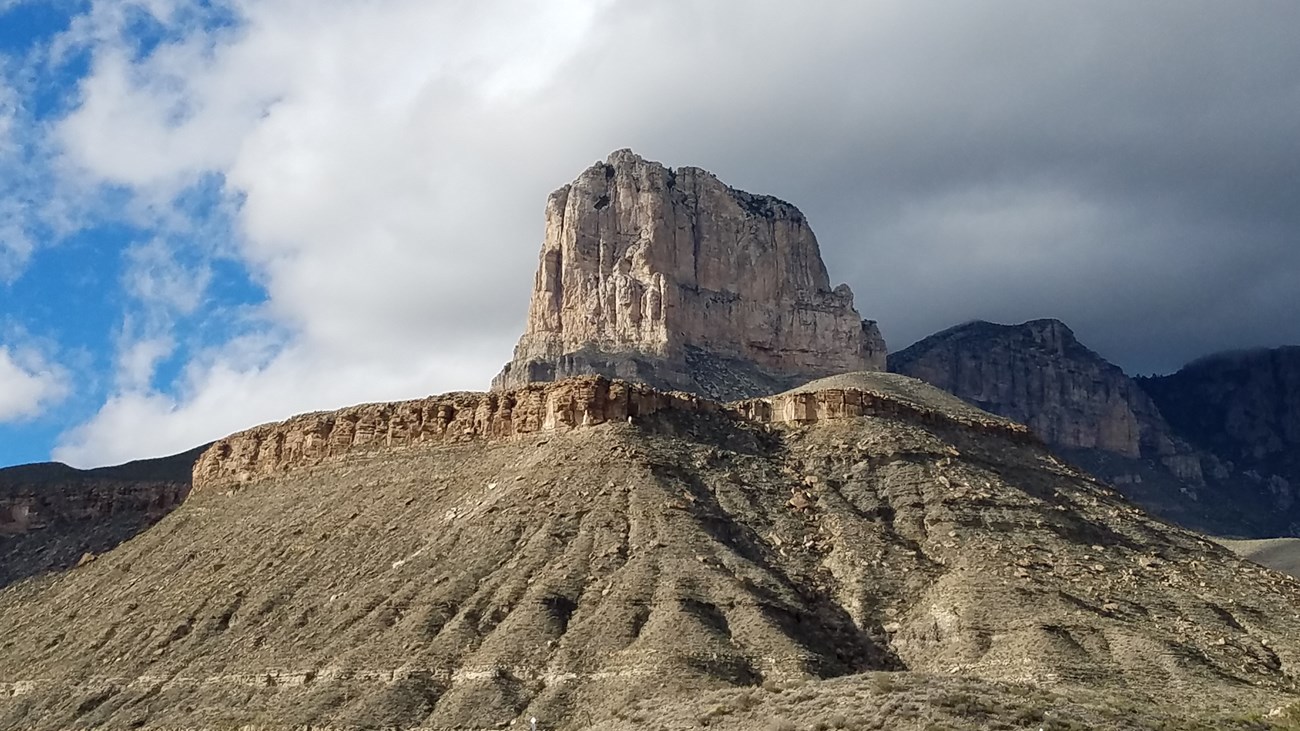Part of a series of articles titled Geologic Time Periods in the Paleozoic Era.
Article
Permian Period—298.9 to 251.9 MYA

NPS image
Introduction
In 1841 British geologist Roderick Impey Murchison named this system from the province of Perm in Russia, where it consists of a great thickness of limestone overlying Carboniferous strata. Before formally naming this system, Murchison ascertained that Permian strata could be identified in widespread areas by their distinctive fossils (Eicher 1976).
Significant Permian events
During the Permian Period, Earth’s crustal plates formed a single, massive continent called Pangaea. In the correspondingly large ocean, Panthalassa, marine organisms such as brachiopods, gastropods, cephalopods (nautiloids and ammonoids), and crinoids were present. On land, reptiles replaced amphibians in abundance. The most devastating incidence of mass extinction in Earth’s history marked the end of the Permian Period.
Learn about what events during the Permian Period
The meeting of continents created arid conditions, just as great deserts are located at the interior of most continents today. Only portions of this vast continent received rainfall throughout the year, and without the moderating effect of nearby bodies of water, great seasonal fluctuations occurred. In addition, the formation of Pangaea reduced the total amount of shoreline, and thus the amount of coastal marine habitat, a possible factor in the extinction at the end of the period that devastated marine life.
By the mid-Permian, other amniote groups appeared. One group, the therapsids, evolved from the pelycosaurs and is important to us because they eventually evolved into mammals. They had complex, powerful jaws with differently shaped teeth that performed various functions. Their legs were positioned more vertically under their bodies, and they likely had warm-blooded metabolisms.
The Permian mass extinction came closer than any other extinction event in the fossil record to wiping out life on Earth. Yet the extinctions of species were selective and uneven. Finding a cause that would affect both land-dwelling and marine organisms is challenging. If the cause was sea-level change, lowering of sea level would greatly reduce shallow, marine habitats, but not terrestrial habitats. Therefore, the probable link between extinctions in these habitats may be climate change. When sea level fell, great quantities of organic deposits from shallow-water organisms became exposed to the atmosphere. Oxidation of this material produced carbon dioxide (CO_2), a greenhouse gas, which traps heat near Earth’s surface. Additionally, one of the largest episodes of continental volcanism occurred at the end of Permian time in what is now central Siberia. The volcanic gases released during the eruptions were sources of greenhouse gases (CO_2 and sulfur dioxide [SO_2]). Because changes in concentrations of greenhouse gases can have substantial effects on climate, a sudden increase in such gases could have had a detrimental effect on many species.
Finally, because Pangaea stretched from pole to pole near the end of the Permian, conditions were appropriate for the formation of polar ice caps, which evidence shows did indeed occur. The large and rapid sea-level fluctuations near the end of the Permian were at least partly the result of waxing-and-waning glaciers. The large sea-level drop at the end of the Permian was followed quite rapidly by general global warming and a substantial rise in sea level. With volcanic eruptions, climatic variability, and abrupt sea-level changes, the world at the end of the Permian was a particularly harsh place for many life-forms. Hence, any or all of these changes could have played a role in the biological devastation that occurred.
Visit—Permian Parks
Every park contains some slice of geologic time. Below, we highlight selected parks associated with the Permian Period. This is not to say that a particular park has only rocks from the specified period. Rather, rocks in selected parks exemplify a certain event or preserve fossils or rocks from a certain geologic age.
-
Alibates Flint Quarries National Monument (ALFL), Texas—[ALFL Geodiversity Atlas] [ALFL Park Home] [ALFL npshistory.com]
-
Carlsbad Caverns National Park (CAVE), New Mexico—[CAVE Geodiversity Atlas] [CAVE Park Home] [CAVE npshistory.com]
-
Canyonlands National Park (CANY), Utahk—[CANY Geodiversity Atlas] [CANY Park Home] [CANY npshistory.com]
-
Death Valley National Park (DEVA), California, Nevada—[DEVA Geodiversity Atlas] [DEVA Park Home] [DEVA npshistory.com]
-
Dinosaur National Monument (DINO), Colorado and Utah—[DINO Geodiversity Atlas] [DINO Park Home] [DINO npshistory.com]
-
Grand Canyon National Park (GRCA), Arizona—[GRCA Geodiversity Atlas] [GRCA Park Home] [GRCA npshistory.com]
-
Grand Canyon-Parashant National Monument (PARA), Arizona—[PARA Geodiversity Atlas] [PARA Park Home] [PARA npshistory.com]
-
Glen Canyon National Recreation Area (GLCA), Arizona and Utah—[GLCA Geodiversity Atlas] [GLCA Park Home] [GLCA npshistory.com]
-
Guadalupe Mountains National Park (GUMO), Texas—[GUMO Geodiversity Atlas] [GUMO Park Home] [GUMO npshistory.com]
-
Natural Bridges National Monument (NABR), Utah—[NABR Geodiversity Atlas] [NABR Park Home] [NABR npshistory.com]
-
Tallgrass Prairie National Preserve (TAPR), Kansas—[TAPR Geodiversity Atlas] [TAPR Park Home] [TAPR npshistory.com]
-
Walnut Canyon National Monument (WACA), Arizona—[WACA Geodiversity Atlas] [WACA Park Home] [WACA npshistory.com]
-
Wrangell-St. Elias National Park and Preserve (WRST), Alaska—[WRST Geodiversity Atlas] [WRST Park Home] [WRST npshistory.com]
More about the Paleozoic
►
Tags
- alibates flint quarries national monument
- canyonlands national park
- carlsbad caverns national park
- death valley national park
- dinosaur national monument
- glen canyon national recreation area
- grand canyon national park
- grand canyon-parashant national monument
- guadalupe mountains national park
- natural bridges national monument
- tallgrass prairie national preserve
- walnut canyon national monument
- wrangell - st elias national park & preserve
- fossils
- paleontology
- geology
- geologic time
Last updated: April 28, 2023

